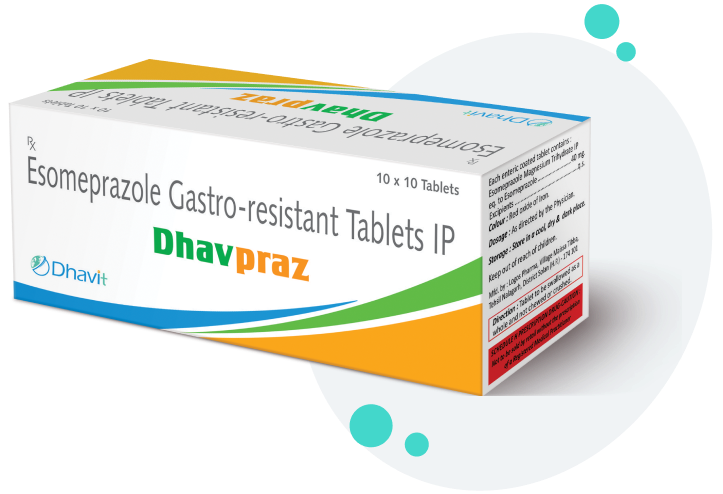
Dhavpraz Tablets
Composition
Each Tablet contains:
| Esomeprazole Magnesium: | 40 mg (as enteric-coated pellets) |
Description
Esomeprazole belongs to a class of antisecretory compounds (substituted benzimidazole proton-pump inhibitors (PPI’s) that do not exhibit anticholinergic or histamine H2-receptor antagonist properties, but suppress gastric acid secretion by inhibiting the gastric H+/K+ ATPase at the secretory surface of the gastric parietal cell. Because this enzyme is regarded as the acid (proton) pump within the parietal cell, esomeprazole has been characterized as a gastric PPI. Esomeprazole blocks the final step of gastric acid secretion. In gastric parietal cells, esomeprazole is protonated, accumulates, and is transformed to an active sulfenamide.
Pharmacodynamics
Esomeprazole
Mechanism of Action
Esomeprazole is a proton-pump inhibitor (PPI) that suppresses gastric acid secretion by specific inhibition of the H+/K+-ATPase in the gastric parietal cell. The S- and R-isomers of omeprazole are protonated and converted in the acidic compartment of the parietal cell forming the active inhibitor, the achiral sulfenamide. By acting specifically on the proton pump, esomeprazole blocks the final step in acid production, thus reducing gastric acidity. This effect is dose-related up to a daily dose of 20 to 40 mg and leads to inhibition of gastric acid secretion.
Pharmacokinetics
Esomeprazole
Absorption
The AUC after administration of a single 40 mg dose of esomeprazole is decreased by 43% to 53% after food intake, compared to fasting conditions. Esomeprazole should be taken at least 1 hour before meals.
Distribution
Esomeprazole is 97% bound to plasma proteins. Plasma protein binding is constant over the concentration range of 2 to 20 µmol/L. The apparent volume of distribution at the steady state in healthy volunteers is approximately 16 L.
Metabolism
Esomeprazole is extensively metabolized in the liver by the cytochrome (CY) P450 enzyme system. The metabolites of esomeprazole lack anti-secretory activity.
Excretion
The plasma elimination half-life of esomeprazole is approximately 1 to 1.5 hours. Less than 1% of parent drug is excreted in the urine. Approximately 80% of an oral dose of esomeprazole is excreted as inactive metabolites in the urine, and the remainder is found as inactive metabolites in the faeces.
Indications
Dhavipraz Tablets – Peptic ulcers, Gastritis, GERD
Dosage and Administration
Dhavipraz Tablets – One tablet, once daily
Contraindications
Dhavipraz are contraindicated in patients with a known hypersensitivity to esomeprazole, domperidone or to substituted benzimidazoles or to any excipients used in the formulation.
It is also contraindicated in patients with a prolactin-releasing pituitary tumour (prolactinoma), hepatic and renal impairment.
Storage and Handling Instructions
Store in a cool and dry place. Protect from light.
Packaging Information
Dhavipraz 40 Tablets – Strip pack of 10 Tablets
Got a question?
We’d love to talk about how we can help you.